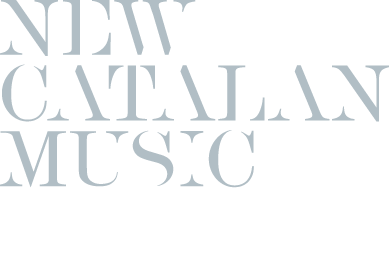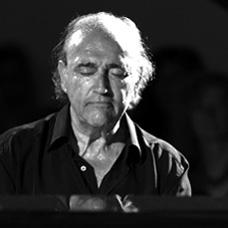Carles Santos
Contemporary music
(Carles Santos, 1940)
Composer, pianist, conductor and performer from Valencia. Versatile and difficult to classify, he needs to be treated as an exception in the world of contemporary music, given the singularity of his creative language.
Trained at the Conservatori del Liceu and with studies in France, Switzerland and the United States (where he met John Cage), his artistic career began in 1961 as a pianist with a repertoire of 20th century music –Bartók, Schönberg, Webern–, which he left in the seventies in order to fully concentrate on his own work. During this period, he also collaborated with the composer Josep M. Mestres Quadreny in the creation of the Grup Instrumental Català (GIC), which he conducted from 1976 to 1979.
The piano, the force behind his tonal universe, is his first instrument of choice, showing to be a true artistic icon with which he keeps an intense physical and emotional relationship, which is particularly visible during his performances. There are many diverse influences that come together in his very personal and unique music, from the Bach rigour and invention to minimalism and Spanish music, even though his most distinguished characteristic might just be the constant use of provoking as a way to reach the audience. Inventor of the opera circus concept, he displays a boundless poetic, visual and aesthetic imagination in all his stage musical shows. Marked with irony, extravagance and eroticism, he has travelled to various international stages, such as the Edinburgh Theatre Festival, the Odeon theatre, the Festival d’Automne de París and the Nits de Fourvière.
His first proposals came out in the early eighties: Beethoven, si tanco la tapa què passa?, premiered on September 25, 1982 at the Plaça del Rei de Barcelona; Minimalet, minimalot, performed in October of that same year at the Centre Georges Pompidou in Paris and in February 1983 at the Teatre Regina in Barcelona; Té xina, la fina petxina de Xina? (1984); La boqueta amplificada (1985) and Misericòrdia Ubach (1986), his first stage work, which would lead to further close collaboration with the visual artist Mariaelena Roqué, costume designer and stage decorator for all of his performances.
Since then, he has brought to stage many shows, each and every one with music and, with the odd exception, script and stage direction. These include Arganchulla, Arganchulla Gallac (1987), Tramuntana Tremens (1989), and La grenya de Pasqual Picanya (1991-1993). The opera Asdrúbila (1992), with stage direction by Pere Portabella, premiered at the Teatre Tívoli in Barcelona during the Festival Olímpic de les Arts, and Santos also wrote and conducted the theme songs for the opening ceremony of the Barcelona 92 Olympic Games. He wrote L’esplèndida vergonya del fet mal fet (1995) and Figasantos-Fagotrop, missatge al contestador: soparem a les nou (1996). His composition La pantera imperial (1997), an iconoclastic approximation to Bach, premiered in Frankfurt in 1997. Ricardo i Elena (2000) is an unsettling look at Spain’s postwar society, which premiered at the Teatre Nacional de Catalunya on March 15, 2000. L’adéu de Lucrècia Borja (2001), with libretto by Joan F. Mira, is a story about love, fortune and politics for the most influential family in Valencia in the 17th century. It premiered its stage version for the opening of the new location for the Teatre Lliure de Barcelona in November 2001. Sama Samaruck, Samaruck Suck Suck (2002), Lisístrata (2003) (based on the Aristophanes classic) and El compositor, la cantant, el cuiner i la pecadora (2003) all premiered at the Teatre Nacional de Catalunya on November 4, 2003. These pieces opened a personal and intimate dialogue with Rossini, a composer who he had already brought to stage in 2000 during the Festival de Peralada with the opera The Barber of Seville. This has been his only contact with opera up until now.
In 2003, the Teatre Lliure named him resident composer, thus beginning a close tie which would lead to premiering a new show on this stage every year. Since then, this artistic residence has resulted in performances such as the award-winning La meva filla sóc jo (2005), El fervor de la perseverança (2006), Brossalobrossotdebrossat (2008), an intimate homage to Joan Brossa, and Chicha Montenegro Gallery. This last piece is a mix of circus, music and other artistic languages. It was performed in October 2010, after having recuperated in February of that same year one of his most emblematic and recognized shows, La pantera imperial¸ often considered the show that best defines this composer’s creative universe.
As a soloist, he has performed piano recitals like No al no, premiered at the Edinburgh Festival Theatre in August 2002, He de ser castigat per no haver estimat mai ningú, a series of six concerts played at the Teatre Lliure in May 2007, and Piturrino fa de músic (2009), a concert that pushes the limits of musical performance. And with the stage director Calixto Bieito, he has performed for the shows Tirant lo Blanc, by Joanot Martorell (Berlín, 2007) and El gran teatro del mundo, by Calderón de la Barca (Friburg, November 2011).
He has also worked in the world of cinema as a composer, performer and screenwriter, in films like Nocturn 29 (1968), Miró, l’altre (1969), Informe general sobre algunas cuestiones para una proyección pública (1976), El pont de Varsòvia (1989) and Les variacions Goldberg (2007). He has also directed: L’àpat (1967), La cadira (1968) and La-re-mi-la (1979).
Throughout his career, he has received thirteen Max theatre prizes, as well as various honour awards acknowledging his unclassifiable artistic personality. Among them are the prize Nacional de Composició de la Generalitat de Catalunya (1990), the awards Ciutat de Barcelona en la modalitat Música (1993) and in Projecció Internacional (1996), Creu de Sant Jordi de la Generalitat de Catalunya (1999), Nacional de Teatre prize (2001), and the Medalla de Oro del Círculo de Bellas Artes (2007). In 2006, the Fundación Miró dedicated to him a large retrospective exhibit of all his artistic activity, entitled «Carles Santos. Visca el piano!», which later went on to other Spanish cities.
In July 2011, the show Maquinofòbia pianolera premiered at the Festival de la Porta Ferrada de Sant Feliu de Guíxols, in collaboration with Cabo San Roque, a group from Barcelona especially known for its prolific imagination when it comes to creating new musical instruments from recycled materials. In November of that same year, at the Festival Temporada Alta de Girona, they premiered Schubertnacles humits, which Santos defines as “a homage to Schubert and to a speaker”. Barcelona’s summer festival Grec 2012 included Cantúria Cantada, a gathering of choral passages of his works performed by the Cor de Cambra del Palau de la Música Catalana.




 twitter
twitter flickr
flickr facebook
facebook RSS
RSS spotify
spotify youtube
youtube
